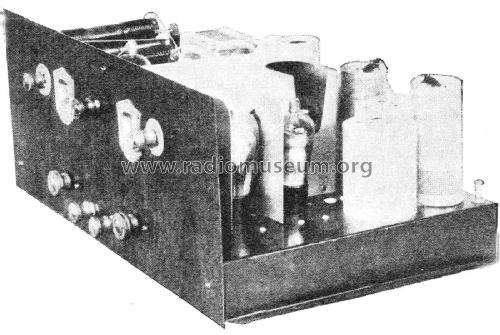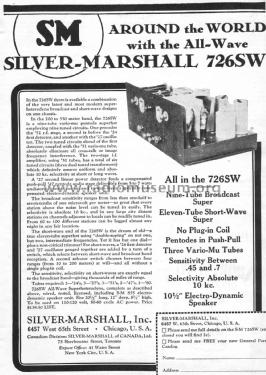All-Wave 726SW (early version)
Silver - Marshall; Chicago, IL
- Produttore / Marca
- Silver - Marshall; Chicago, IL
- Anno
- 1931
- Categoria
- Radio (o sintonizzatore del dopoguerra WW2)
- Radiomuseum.org ID
- 57942
Clicca sulla miniatura dello schema per richiederlo come documento gratuito.
- Numero di tubi
- 11
- Principio generale
- Supereterodina a doppia / tripla conversione; ZF/IF 175 kHz; A valvole con griglia schermo (solo se 1926-1935)
- N. di circuiti accordati
- 11 Circuiti Mod. Amp. (AM)
- Gamme d'onda
- Onde medie (OM) e più di 2 gamme di onde corte (> 2 x OC).
- Tensioni di funzionamento
- Alimentazione a corrente alternata (CA) / 110-120 Volt
- Altoparlante
- AP elettrodinamico (bobina mobile e bobina di eccitazione/di campo) / Ø 10.5 inch = 26.7 cm
- Materiali
- Mobile di metallo, valvole visibili
- Radiomuseum.org
- Modello: All-Wave 726SW - Silver - Marshall; Chicago, IL
- Forma
- Chassis o in scatola da montaggio
- Dimensioni (LxAxP)
- 20.5 x 8.5 x 12 inch / 521 x 216 x 305 mm
- Annotazioni
- If this model 726SW hat for the start the tube 35 or 235 then it can only be from May 1931 or later. One dial (primary tuning control knob); push-pull output stage. Probably only for the new version: As a short wave broadcast receiver, the antenna is fed into the short wave detector circuit using a 24 type tube. A short wave oscillator of special design using a '27 tube, operating at 650 kc away from the short wave detector heterodynes the incoming signal to the frequency to which the RF stage of the broadcast receiver is tuned, the broadcast tuning dial being set on a clear channel at approx. 650 kc for best results. As a short wave super, there are therefore three detectors and two oscillators, giving so called double "suping".
- Fonte esterna dei dati
- Ernst Erb
- Fonte dei dati
- Radio Collector`s Guide 1921-1932
- Riferimenti schemi
- Rider's Perpetual, Volume 1 = 1931/1934 (for 1919-1931)
- Altri modelli
-
In questo link sono elencati 225 modelli, di cui 116 con immagini e 122 con schemi.
Elenco delle radio e altri apparecchi della Silver - Marshall; Chicago, IL



